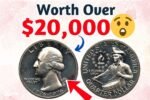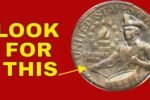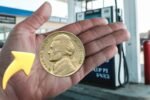The Kennedy Coin That’s Now Worth Over $50,000: What began as a routine spring cleaning project turned into a life-changing moment for one Pennsylvania family. While going through their late grandfather’s belongings in the garage, they opened an old, dusty toolbox and stumbled upon what looked like just another coin. But as it turns out, this wasn’t just any coin—it was a rare 1964 Kennedy half dollar now valued at over $50,000.
This is the story of an ordinary family, an extraordinary discovery, and a coin that turned into both a financial windfall and a powerful link to the past.
Step 1: An Unexpected Find in a Toolbox
It all started on a quiet Saturday afternoon. The family was sorting through decades of tools, trinkets, and keepsakes stored in their grandfather’s workshop. Amid the wrenches and screwdrivers, they found a small tin filled with miscellaneous coins. Most were common pennies and nickels, but one stood out—a silver-toned Kennedy half dollar dated 1964.
Initially, no one thought much of it. The coin seemed like a nice memento, likely saved for sentimental reasons. But one of the family members, a college student with a passing interest in coin collecting, noticed something odd. The details on President Kennedy’s face and the inscriptions seemed slightly duplicated. This small irregularity turned out to be a massive clue.
The Lincoln Wheat Penny Valued at $80 Million, Still in Circulation
Step 2: A Closer Look Reveals a Rare Error
Intrigued, the family took the coin to a local coin dealer, who confirmed what they suspected: the half dollar featured a double die obverse—a rare minting error where the coin’s design is accidentally stamped twice, slightly off-center.
Double die coins are highly sought after by collectors because they result from a mistake during production, and very few exist. In the case of the 1964 Kennedy half dollar, only a limited number were minted with this error, making it an especially valuable and historic find.
Step 3: The Coin’s Historical Importance
The Kennedy half dollar holds a unique place in American history. First minted in 1964, just months after President John F. Kennedy’s assassination, it was created as a tribute to his legacy. That year’s coins were made with 90% silver, and millions were produced for circulation. However, very few were struck with the double die error.
The family’s coin had remained hidden in that toolbox for decades, completely untouched. This meant it was in excellent condition, which significantly boosted its value. According to the coin expert, similar examples in near-mint condition had sold for over $50,000 at auction.
The Rare Bicentennial Quarter Valued at $1 Million, Still in Circulation
Step 4: From Sentimental Object to Priceless Heirloom
The discovery stirred a mix of emotions in the family. Beyond the monetary value, the coin became a symbol of their grandfather’s quiet legacy. He was a modest, hardworking man who likely tucked the coin away without knowing its potential worth. To the family, it felt like a final gift—both meaningful and surprising.
Rather than immediately selling it, they decided to have it professionally graded and preserved. The plan is to keep it as a family heirloom, a lasting reminder of both their grandfather’s life and the unexpected joys of paying attention to the small things.
Step 5: A Nationwide Trend of Rediscovery
This story isn’t unique. Across the country, people are finding valuable collectibles in old drawers, attics, and garages. The rise of online marketplaces and TV shows about antiques has sparked renewed interest in collectibles, especially among younger generations.
Coin dealers report an uptick in visits from people bringing in old change jars, hoping to uncover a hidden gem. And sometimes, they do—especially when they know what to look for.
Step 6: How You Can Spot a Valuable Coin
If you want to try your luck, here are a few tips:
- Check the Date: Coins from key years like 1964 (for half dollars) or 1943 (for pennies) can be highly valuable.
- Look for Errors: Doubling, misprints, off-center designs, or missing details may increase a coin’s value.
- Inspect Mint Marks: Letters like “D” (Denver) or “S” (San Francisco) can indicate special mint origins.
- Preserve Condition: The better the shape, the higher the value—store coins safely and avoid cleaning them.
If you suspect a coin is valuable, get a professional appraisal or send it to a certified grading service.
Final Thought: Hidden Treasures Are Everywhere
For the Pennsylvania family, what started as a simple act of cleaning turned into a cherished story. The Kennedy half dollar not only offered potential wealth but reconnected them with their grandfather’s life in an unexpected, powerful way.
Sometimes, the past speaks through the quietest objects—a coin, a photo, or a letter tucked away for years. So the next time you find yourself digging through old belongings, pause before tossing anything aside. You might just hold history in your hands.
FAQs About The Kennedy Coin That’s Now Worth Over $50,000
Q1: What makes the Kennedy coin found in the toolbox so valuable?
A: It’s a rare 1964 Kennedy half dollar with a “double die obverse” minting error, making it highly sought after by collectors.
Q2: How rare is this type of coin?
A: Very rare—only a small number of 1964 Kennedy half dollars have this mint error, especially in near-perfect condition.
Q3: Could I find a valuable coin like this too?
A: Yes! Rare coins are sometimes hidden in old collections, toolboxes, or jars—check for mint errors, silver content, and unusual markings.




